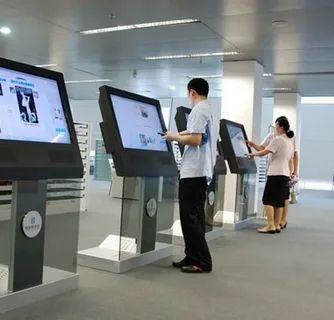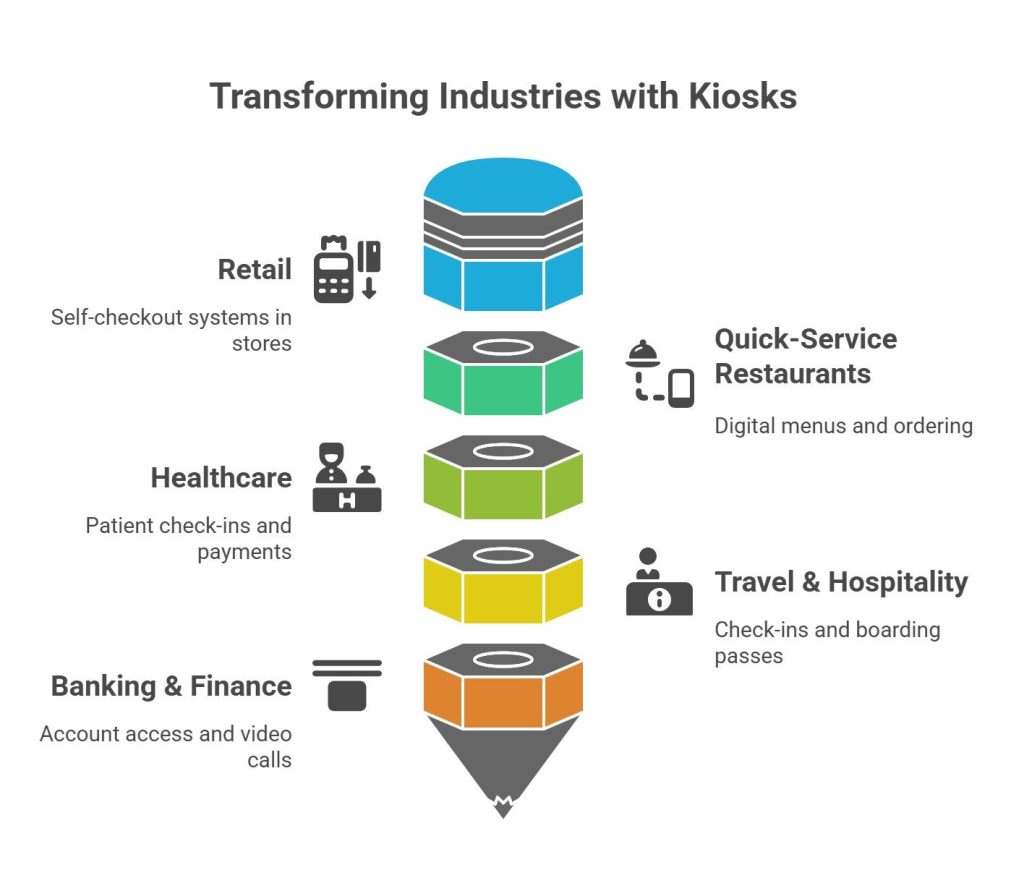In a digitally driven world, businesses are in constant pursuit of tools that streamline operations, reduce costs, and enhance the customer experience. One such tool is quietly transforming interactions across industries — the kiosk machine. You may have used one at a mall, an airport, or even a fast-food restaurant without giving it much thought. But today, it’s time to explore the question: What is a kiosk machine, and why is it becoming indispensable in modern customer service?

From Static Kiosks to Smart Machines
To understand what a kiosk machine is, let’s rewind a little.
Traditional kiosks were standalone booths or terminals designed to offer specific information or services, like ticket printing or directions. However, today’s kiosk machines are far more advanced. They are sophisticated, touch-enabled systems embedded with software that allows users to perform complex transactions without human assistance.
So, what is a kiosk machine in its modern sense? It’s a self-service, interactive system equipped with hardware (screens, sensors, printers, card readers) and software (custom UIS, integrations, security protocols) that allows customers to access services efficiently. Whether it’s placing an order, checking into a hospital, or applying for a bank loan, kiosk machines handle it all — often faster and with more personalisation than a human agent.
Real-World Applications of Kiosk Machines – Uses

You’ll find kiosk machines everywhere, and their usage is growing rapidly. Here’s a look at the industries being transformed by them:
1) Retail
Self-checkout kiosk devices have become a staple in grocery stores and supermarkets. Customers can simply scan items without waiting at check-out terminals. Not only does this reduce wait times, but it also optimizes staffing needs for retailers.
2) Quick-Service Restaurants
Global fast food chains and cafes have adopted kiosk services. Customers browse digital menus, customize their meals, and pay — all without interacting with a cashier.
3) Healthcare
Kiosk machines in hospitals allow patients to check in, update their information, and even make co-payments. These machines streamline the patient intake process and reduce administrative overhead.
4) Travel & Hospitality
Airports and hotels use kiosks for check-ins, boarding passes, room assignments, and feedback collection. These machines expedite processes that used to take several minutes down to just a few taps.
5) Banking & Finance
ATM-like kiosk machines offer services like account access, loan applications, and even video calls with banking professionals. This makes financial services more accessible in both rural and urban areas.
These examples make it clear: What is a kiosk machine? The answer lies not just in its form but in its growing functionality across sectors.
How Kiosk Machines Improve Customer Experience
Now, let’s explore how kiosk machines are silently reshaping customer interactions.
1. 24/7 Availability
Unlike human staff, kiosk machines can operate around the clock. Whether it’s checking into a hotel at midnight or paying a bill during lunch hour, customers appreciate the flexibility.
2. Faster Service
Speed is one of the biggest draws. Kiosks reduce queues, eliminate human error, and let customers control their pace, be it fast or slow.
3. Personalization
Smart kiosk machines can offer personalized suggestions based on past purchases, language preferences, or demographic data, making the experience feel tailored rather than transactional.
4. Multilingual Access
In regions with linguistic diversity, kiosk machines can cater to multiple languages — something that’s hard to scale with human support.
5. Accessibility Features
Touchscreens with adjustable heights, screen readers, and braille pads help make services more inclusive for differently-abled individuals.
By integrating these features, kiosk machines aren’t just efficient; they’re empathetic, offering an experience that adapts to individual needs.
Behind the Screen: The Technology Powering Kiosk Machines
What is a kiosk machine? It’s not just the screen you see — what lies beneath makes kiosk machines powerful.
1) User Interface (UI) Design
Modern kiosks come with clean, intuitive UIs that mimic the familiarity of mobile apps. Simple icons, logical navigation, and responsive design are key components.
2) Backend Integrations
A kiosk machine is only as good as its ecosystem. Seamless integration with inventory systems, CRMS, payment gateways, and even AI chatbots is what makes the experience smart and smooth.
3) Real-Time Data Analytics
Kiosks track usage patterns, customer preferences, and dwell time — data that businesses can use to refine their services and layouts.
4) Security Features
With increased digital access comes the risk of fraud or data breaches. Kiosk machines use encrypted communications, biometric verifications, and firewall protections to keep transactions secure.
So again, what is a kiosk machine? It’s your digital receptionist, cashier, guide, and analyst, all rolled into one.
What is a Kiosk Machine? – The Future
Looking ahead, the future of kiosk machines will continue to evolve beyond touchscreen interfaces.
1) AI-Powered Recommendations
Imagine walking up to a kiosk that recognizes your face and recommends products based on past preferences — it’s already happening in some parts of Asia.
2) Voice-Enabled Interaction
Voice-enabled kiosks offer greater accessibility and convenience, especially for visually impaired users or those in a hurry.
3) Remote Support Integration
Live video support from remote agents will bring human interaction back into the mix when necessary, creating a hybrid service model.
These innovations will blur the lines between manned service and machine-based convenience, proving that kiosk machines are here to stay — and they’ll only get smarter.
Conclusion
So, what is a kiosk machine really? It’s an operational tool that helps customers interact professionally with brands. From retail stores to hospitals, these quiet, efficient devices are shaping the future of customer experience. As technology advances and customer expectations grow, kiosk machines will only become more intelligent, intuitive, and indispensable.
Businesses that invest in them aren’t just upgrading hardware — they’re reimagining service delivery. In a world where experience is everything, kiosk machines may just be your most powerful customer ally. Want the latest kiosk technology? Contact Qodenext right now.
FAQS: What is a Kiosk Machine?
1. What is a kiosk machine in simple terms?
A kiosk machine is a self-service digital terminal that allows users to access services, make purchases, or retrieve information without human assistance.
2. Are kiosk machines only for large businesses?
Not at all. Small businesses are increasingly adopting kiosk machines to save costs, speed up service, and offer modern convenience to their customers.
3. Who uses kiosks?
Kiosks are interactive machines used primarily for sales and marketing purposes. They can be used by business executives to track user interactions and customers to purchase items.
4. How to use a kiosk machine?
Most kiosk machines have user instructions displayed on the screen for first-time use. Follow the touchscreen prompts to select your language, payment mode, and menu options.
5. Can kiosk machines be customized for any industry?
Yes. Kiosk machines can be tailored with specific software, UI, and hardware to serve industries like healthcare, retail, hospitality, banking, and even government services.
6. What are the main types of kiosk machines available today?
The main types include self-service kiosks (for retail, dining, and ticketing), informational kiosks (for wayfinding or directory services), interactive kiosks (with touchscreens for customer input), payment kiosks (for bill payments and financial transactions), and check-in/check-out kiosks (for hotels, hospitals, or events). Each is tailored to specific industry needs and customer journeys.
7. How do kiosk machines benefit businesses beyond customer service?
Kiosk machines help businesses reduce operational costs by automating routine tasks, collect valuable customer data for analytics, and improve resource allocation by freeing employees for more complex or personalized support. They also help minimize long queues, reducing customer frustration and increasing transaction throughput.
8. What security measures should be considered when deploying kiosk machines?
Essential security measures include encrypted data transmission, secure payment gateways, user authentication (such as biometric or PIN), anti-virus/malware protection, and robust physical design to prevent tampering. Regular software updates and audit logs further safeguard sensitive customer and business data.
9. Can kiosk machines accommodate digital payments and contactless transactions?
Yes, most modern kiosk machines are equipped to accept multiple payment modes: credit/debit cards, mobile wallets, QR code scanning, NFC (contactless), and even cash. This flexibility ensures convenience and supports evolving customer payment preferences.
10. How do businesses maintain and update kiosk machines?
Routine maintenance includes regular hardware checks, cleaning screens and peripherals, updating software/firmware, monitoring network connectivity, and troubleshooting technical issues. Cloud-based kiosks can often be managed and updated remotely, ensuring quick deployment of new features or security patches.






